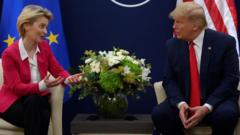Will the EU Finalize a US Tariff Deal Soon?

Understanding the Recent Developments in EU-US Tariff Negotiations
The ongoing discussions between the European Union (EU) and the United States regarding potential tariffs have created significant interest and concern among global market participants. As the largest trading partner for the US, the EU's relationship with America is pivotal for the economic stability of both regions. With US President Donald Trump asserting potential tariffs on various goods, the stakes are high. This article will explore the intricacies of the negotiations, the implications of tariffs, and what they mean for the future of transatlantic trade.
The Context of EU-US Trade Relations
Trade relations between the EU and the US have historically been complicated yet robust. The EU is the US's largest trading partner, responsible for a substantial portion of imports and exports. According to recent statistics, bilateral trade in goods and services exceeds $1 trillion annually. This relationship facilitates not only economic growth but also job creation across both regions. However, the trade landscape has changed dramatically in recent years, particularly with the introduction of tariffs and trade barriers.
In April 2023, President Trump announced a series of tariffs targeting European goods, citing trade imbalances and unfair practices. The proposed levies, initially set at 20%, have sparked concern among EU officials and American businesses alike. As negotiations continue, the potential for both sides to reach a mutually beneficial agreement remains crucial. A successful deal could mitigate the risks associated with escalating tariffs and economic fallout.
The Latest Developments in Negotiations
As of late July 2023, the EU has expressed optimism about reaching a tariff agreement with the US soon. Olof Gill, an EU spokesperson, indicated that a deal could be finalized before the new August 1 deadline imposed by Trump. This optimistic outlook contrasts with Italian Economy Minister Giancarlo Giorgetti's assessment that the ongoing talks remain "very complicated." Such differing views highlight the uncertainty that characterizes these negotiations.
The extension of the deadline from July 9 to August 1 has provided both parties with additional time to explore potential compromises. However, the looming threat of tariffs has compelled other trading partners, such as Japan and South Korea, to prepare for possible repercussions. Analysts have noted that moving forward with the proposed tariffs could have significant ramifications for the US economy, given the interconnectedness of global trade.
The Economic Implications of Tariffs
Tariffs serve as a tool for governments to protect domestic industries by making imported goods more expensive. However, they can also lead to increased costs for consumers and businesses alike. The potential introduction of tariffs by the US could result in:
- Higher Prices: As tariffs increase the cost of imported goods, consumers may face higher prices for everyday products.
- Market Volatility: The uncertainty surrounding trade negotiations can lead to fluctuations in financial markets, affecting stock prices and investment decisions.
- Retaliatory Measures: The EU has indicated its readiness to respond with retaliatory tariffs, which could escalate trade tensions and disrupt established supply chains.
- Impact on Employment: Industries that rely heavily on exports could face job losses if tariffs are implemented, leading to broader economic concerns.
Given these implications, analysts warn that the US economy may suffer if a trade war ensues. The potential for decreased consumer spending and investment could hinder economic growth, making it essential for both sides to find common ground.
The Role of Domestic Politics
The political climate in the US plays a significant role in the tariff discussions. With the upcoming elections, Trump’s administration is eager to showcase a strong stance on trade, appealing to his voter base. However, the risks associated with aggressive tariff policies could alienate key stakeholders, including American farmers and manufacturers who rely on exports.
Commerce Secretary Howard Lutnick has mentioned that the EU has made "significant, real offers" that could facilitate American farmers' access to European markets. This acknowledgment suggests a willingness from both parties to engage in constructive dialogue. Yet, the complexity of domestic politics means that any agreement must balance the interests of various constituencies.
The Reaction from Global Markets
Despite the ongoing negotiations and the looming threat of tariffs, markets in Europe have shown resilience, with some analysts describing investor sentiment as shifting from a state of panic to a "wait and see" mode. This change reflects a growing skepticism regarding the credibility of Trump's negotiating tactics. Analysts have even coined the term "TACO" (Trump Always Chickens Out) to describe the market's perception of his tariff threats.
This evolving sentiment indicates that investors are becoming increasingly cautious but are not entirely dismissive of the potential for a positive outcome. The muted response from markets suggests that many traders are aware of the complexities involved in tariff negotiations and are prepared for various scenarios.
Looking Ahead: What Lies Beyond the Negotiations?
The outcome of the EU-US tariff negotiations remains uncertain. A successful agreement could enhance trade relations and alleviate economic concerns, while failure to reach a consensus may lead to escalating tensions and economic repercussions. The importance of maintaining open lines of communication cannot be understated, as both parties must navigate the complexities of trade in an increasingly interconnected world.
As the August 1 deadline approaches, market participants and policymakers alike will be closely monitoring developments. The potential for changes in tariff rates could have significant consequences for global trade dynamics, impacting everything from consumer prices to international supply chains.
FAQs
What are the potential consequences of US tariffs on EU goods?
The potential consequences of US tariffs on EU goods include higher prices for consumers, retaliatory measures from the EU, market volatility, and impacts on employment in export-driven industries.
Why are tariffs imposed by the US government?
The US government imposes tariffs to protect domestic industries from foreign competition, address trade imbalances, and generate revenue. However, they can also lead to unintended economic consequences.
How do tariffs affect global trade?
Tariffs can disrupt global trade flows by increasing the cost of imported goods, leading to reduced demand for those products. This can result in retaliatory tariffs and further escalation of trade tensions.
What is the significance of the EU as a trading partner for the US?
The EU is the largest trading partner for the US, accounting for a substantial share of imports and exports. A healthy trade relationship benefits both regions economically and promotes job creation.
What strategies might the EU employ if tariffs are implemented?
If tariffs are implemented, the EU may respond with retaliatory tariffs on US goods, seek alternative markets for exports, or engage in diplomatic negotiations to alleviate trade tensions.
In conclusion, the EU-US tariff negotiations represent a critical juncture in international trade. As both parties strive to reach an agreement, the potential implications for economies worldwide are profound. How both sides navigate these complex discussions will determine not only their economic futures but also the stability of global trade. Will they find common ground, or will tensions escalate further? #TradeNegotiations #EUTariffs #USTariffs
Published: 2025-07-09 15:37:04 | Category: technology



